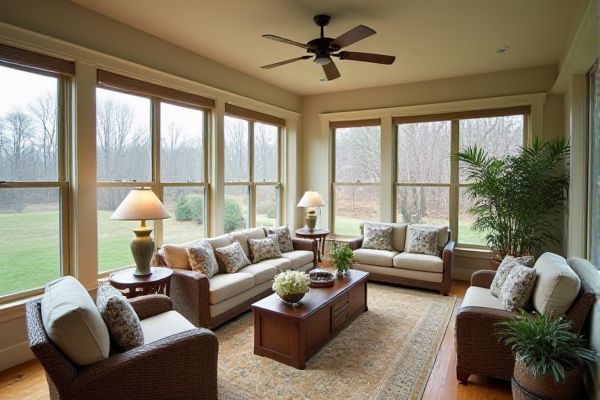
Choosing between a ceiling fan and a tower fan for your sunroom depends on factors like airflow direction, space, and aesthetics; ceiling fans provide widespread circulation from above, while tower fans offer portability and targeted cooling. Explore the rest of the article to discover which option best suits your sunroom's comfort needs and design preferences.
Table of Comparison
| Feature | Ceiling Fan | Tower Fan |
|---|---|---|
| Installation | Requires mounting to ceiling, professional setup recommended | Portable, no installation needed |
| Space Usage | Ceiling space only, frees floor space | Occupies floor space, compact footprint |
| Air Circulation | Provides broad, even airflow across sunroom | Focused, directional airflow, adjustable oscillation |
| Energy Efficiency | Generally more energy-efficient for whole-room cooling | Consumes moderate energy, suited for localized cooling |
| Noise Level | Quiet operation | Varies from quiet to moderate noise depending on model |
| Cost | Higher upfront cost, long-term value | Lower initial cost, easy to replace |
| Best For | Large sunrooms needing consistent airflow | Small to medium sunrooms or targeted cooling |
Introduction: Comparing Ceiling Fans and Tower Fans for Sunrooms
Ceiling fans provide efficient air circulation for sunrooms by utilizing overhead airflow to cool larger spaces evenly. Tower fans offer portability and sleek design, making them ideal for targeted airflow and easy repositioning in sunroom areas with limited ceiling height. Choosing between ceiling fans and tower fans depends on space size, airflow needs, and aesthetic preferences in sunroom environments.
Key Differences Between Ceiling Fans and Tower Fans
Ceiling fans and tower fans differ primarily in installation and airflow direction, with ceiling fans mounted on the ceiling circulating air over a wider area while tower fans are portable and direct airflow at a specific spot. Ceiling fans typically offer more powerful airflow and energy efficiency for cooling larger spaces like sunrooms, whereas tower fans provide targeted cooling with adjustable oscillation perfect for smaller or more confined areas. Your choice depends on sunroom size, desired cooling intensity, and whether a permanent or movable solution better suits your needs.
Cooling Efficiency in Sunrooms: Which Fan Performs Better?
Ceiling fans offer superior cooling efficiency in sunrooms by circulating air evenly across the entire space, promoting better ventilation and reducing heat buildup. Tower fans, while compact and portable, tend to provide localized airflow that may not cool larger sunrooms as effectively. Selecting a ceiling fan with adjustable speed settings and a reverse function enhances comfort and energy efficiency in sunroom environments.
Space and Installation Considerations
Ceiling fans save floor space in your sunroom by mounting directly overhead, making them ideal for smaller or crowded areas where floor or wall space is limited. Tower fans offer flexible placement options and are easier to install, requiring only an electrical outlet without any wiring or ceiling support. Your choice depends on available space, ease of installation, and whether you prefer a permanent overhead fixture or a portable cooling option.
Energy Consumption: Ceiling Fan vs Tower Fan
Ceiling fans typically consume between 15 to 90 watts, making them more energy-efficient for continuous use in a sunroom compared to tower fans, which generally use 40 to 100 watts. Tower fans offer portability and targeted airflow but may increase your energy costs if run for extended periods. For optimizing energy consumption in your sunroom, choosing a ceiling fan with an energy-efficient motor and variable speed settings can reduce electricity usage while maintaining comfort.
Aesthetic Appeal and Design Suitability
Ceiling fans in sunrooms offer a classic and unobtrusive aesthetic that seamlessly integrates with traditional or rustic decor, creating an elegant overhead focal point. Tower fans provide a modern, sleek design ideal for minimalist or contemporary spaces, enhancing room aesthetics without permanent installation. Choosing between the two depends on desired visual impact and spatial layout, with ceiling fans complementing high ceilings and tower fans fitting compact or multifunctional areas.
Noise Levels: Which Fan is Quieter for Sunroom Use?
Ceiling fans generally produce lower noise levels compared to tower fans, making them ideal for maintaining a tranquil atmosphere in a sunroom. The aerodynamic design and steady air circulation of ceiling fans reduce operational noise, whereas tower fans often generate higher pitch sounds due to their compact motor and blade configuration. Choosing a ceiling fan can ensure quieter cooling, enhancing comfort during prolonged sunroom use.
Maintenance and Longevity
Ceiling fans in sunrooms generally require less frequent cleaning due to their elevated position, reducing dust accumulation and prolonging motor life, while tower fans demand regular filter and surface cleaning to maintain airflow efficiency. The robust construction of ceiling fans often results in longer operational lifespans compared to tower fans, which may experience wear from portable use and exposure to sunroom elements. Proper maintenance for ceiling fans includes lubricating motors and tightening blades, whereas tower fans benefit from occasional disassembly for internal dust removal to ensure optimal performance.
Cost Comparison: Upfront and Long-Term Expenses
Ceiling fans typically have higher upfront costs ranging from $100 to $300, but their energy-efficient operation results in lower long-term electricity expenses compared to tower fans, which cost between $50 and $150 initially but often consume more power over time. Maintenance for ceiling fans usually involves occasional cleaning and motor lubrication, whereas tower fans may require more frequent filter changes or part replacements, impacting overall costs. Your choice depends on balancing initial investment with ongoing energy and upkeep expenses for optimal budget management in your sunroom.
Choosing the Best Fan for Your Sunroom Needs
Selecting the best fan for a sunroom depends on factors like room size, airflow needs, and aesthetic preferences. Ceiling fans provide powerful, evenly distributed air circulation ideal for larger sunrooms, while tower fans offer portability and adjustable airflow suitable for smaller or more flexible spaces. Consider energy efficiency, noise levels, and installation requirements to ensure optimal comfort and functionality.
 homyna.com
homyna.com